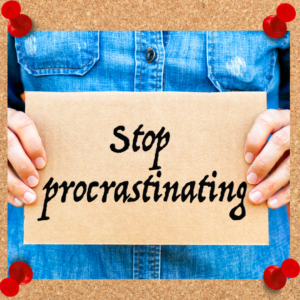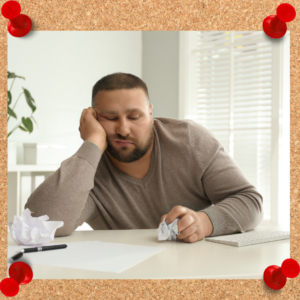Do you ever find it difficult to stop procrastinating? I’ve been there. Sometimes it’s challenging to stop the Netflix binge and get off the couch. Other times, it’s hard to stop browsing social media, reading a good book, or working on an unrelated project or task. The ability to stop procrastinating can be a massive benefit – but it doesn’t have to be a talent that comes naturally.
There are effective practices you can put into place to stop procrastinating, friends. I know because I’ve done it. I’ve had some highly productive days after starting with procrastination.
Just because you’ve procrastinated for an hour doesn’t mean you can’t get things done. That’s something that I used to tell myself, too: “You’ve already wasted the morning; there’s no reason to try and take back the day now! I can catch up tomorrow.”
I’m not alone in that thought, right? Didn’t think so.
What is Procrastination?
Procrastination is nothing new. People have been partaking in procrastination since the dawn of time – it didn’t come with modern technologies! Some Biblical stories point to procrastination, like the one in Matthew 25.
In Matthew 25, a story is told about ten young women waiting to go to a wedding – a party! Five women prepare for the groom coming to get them for their attendance by gathering oil for their lamps. The other five opt out of extra oil. All of the women take a nap, and when they wake, more oil is needed for their lamps.
The five without extra ask the other women to share what they have, but they do not have enough to go around. The five unprepared (procrastinating) women must leave to get more oil. While they are gone, the groom shows up and takes the other five women to the party, and the door closes behind them. The procrastinators show up at the door and are denied entry without the groom to walk them inside.
So, what is procrastination? Procrastination is doing something other than what you should be doing at that moment. It’s putting off what is necessary for what is less necessary. Procrastination is a lack of self-control in the face of time management.
We must learn to stop procrastinating. But how? Start with the reason for procrastination.

What Makes People Procrastinate?
What is it about procrastination that is so enticing? It’s this: we live in a time of instant gratification. If we want something, a few clicks here and there, and voila! We’ve got it.
The problem is that instant gratification doesn’t apply to every aspect of our lives. We can’t instantly finish our to-do list, nor can we instantly lose 25 pounds. We can’t instantly write a 5000-page paper and receive an A+ grade. Getting a raise or promotion, implementing significant changes, generating genius ideas, and so many more examples do not fall under instant gratification.
If we can’t have it instantly, we’ll go for what we can have instantly.
That’s the biggest driver for many procrastinators. What can we get now?
We can find out what happens after that episode’s cliffhanger. Or, we could have another delectable coffee. We might even research how our work could become instantaneous – hello, AI! Those things are gratifying in a way that long-term goals are not.
Procrastinating vs. Being Lazy
Is procrastinating and being lazy synonymous? Surprisingly, no.
You can do things that need to get done and still be procrastinating against the more significant task that needs to get done. For instance, let’s say you need to complete a 10-page proposal for your boss. But you also need to review the last week’s less important emails and respond. If you go through those emails, you aren’t lazy. You’re procrastinating.
Of course, you could also be lazy while procrastinating. If your procrastinating activity is something completely unproductive, you’re probably being lazy.
Sorry – that’s the truth.
Is Your Procrastination Acute or Chronic?
What does your procrastination look like? If you want to stop procrastinating, you have to know how you’re doing it. If you have acute procrastination, you are a “sometimes” procrastinator. It’s entirely possible to fix that problem rather quickly. On the other hand, if you’re a chronic procrastinator, you’re a “most of the time” procrastinator. That’s a tough one to beat.
How often do you find yourself procrastinating? Do you find yourself writing the same to-do list items day after day? Has procrastination become a habit? What makes you want to procrastinate?
Answering these questions can be enlightening to your style of procrastination. They can also help you become more aware of your procrastination situations and drivers to develop the best course of action moving forward.

How to Stop Procrastinating
So, you want to stop procrastinating. I get it. Less procrastination = greater productivity = more money. Let’s dig into the primary process for defeating procrastination.
1. Recognize procrastination.
You might think, of course, I know when I’m procrastinating. I’m not doing what I know I should be doing! Unfortunately, many people fail to realize they are putting things off until it’s down to the wire (or over the wire. Yikes.).
It can be hard to see if your procrastination methods look like work. So you have to look for it. If you’ve included the same item on your calendar for the last four days in a row and have yet to complete it, you might be guilty of procrastination. To stop procrastinating, you must recognize bust work for what it is.
2. Create strong habits.
I’m always amazed by this fact, so I’ll share it repeatedly: 40% of our day is ruled by habits. Nearly half of our time is so deeply ingrained in our behavior that we don’t even have to think about doing it. Your morning routine, what you do when you get to work, your lunch break, your workout routine, what you do before bed, and so many more actions throughout your day is a habit.
If you have developed the habit of procrastination, you have the challenge of breaking that habit.
If you have developed a habit of a strong work cycle, you can rely on that habit to carry you beyond procrastination.
When you want to stop procrastinating, you simply (ha, simply!) need to create a strong habit surrounding your work time. This might mean using the Pomodoro technique or the Flowtime technique. It may be sitting down at your desk and visualizing what you will accomplish for a few minutes.
Create a habit or series of habits that help you get to work when you need to.
3. Crackdown on goal setting.
Goals are a great way to drive yourself toward something achievable. However, it is vital to make your goal-setting an effective process. Pulling goals out of thin air is not likely to be something you work toward with your whole heart and effort.
To create practical goals, you have to find the sweet spot. They can’t be too easy, and they can’t be unrealistic. An unrealistic goal will create a cause for procrastination because you know, deep down, that you’re not going to reach that goal. An easy goal says, “I can do that later; it will be a quick task.”
Goal setting requires a lot of thought. Take the process seriously, friends.
My goal getting packet might help!
4. Determine procrastination drivers.
What makes you procrastinate? Ask yourself questions and be completely honest in the answers. Is there a particular task that you always put off? Is there an activity that you always turn to for procrastinating? What are you doing when you start to procrastinate?
Finding out what forces you off track can help you avoid the driver or change your environment somehow. For instance, if you determine your procrastination activity to be cleaning and reorganizing your desk, there are steps that you can take to prevent that activity. You might spend the last 10 minutes of your day cleaning up the day’s mess to avoid that procrastination tomorrow.
5. Develop a daily plan of action.
A to-do list is helpful but isn’t specific enough to fight against procrastination. The “I can do that tomorrow” excuse is easy when moving around a to-do list. Instead, schedule your entire day – a daily plan of action.
I’ve developed a downloadable planner with a handy daily planner included. You can get that here.
By knowing what you’ll be doing and when you’ll be doing it, you can determine when breaks are acceptable. If you want to watch an episode on Netflix, put it on the schedule. But, when it’s time to work on that specific task, you work on that task.
6. Put the plan to work.
Don’t just write down your plan. You have to use it. In fact, writing out a plan or schedule can be a procrastination activity in itself. I’ve been guilty of that before!
Writing out your schedule can be a fun way to determine what will get done. You should probably even include when you’ll be creating your plan on your schedule. However, you cannot expect to revise your plan again and again and still defeat procrastination. If you’re struggling with that, there are some effective tricks to stop procrastinating.

What are Effective Tricks to Stop Procrastinating?
When you’ve gone through the “How to Stop Procrastinating” steps and still find yourself drifting off task, some great little tricks can help you remain focused on the task at hand.
7. Use “The Nothing Alternative”
I recently heard about this and loved the idea, so I felt compelled to include it here. “The Nothing Alternative” comes from author Raymond Chandler, who had trouble focusing on his writing. So, he decided he could either write during a specified time or he could do nothing. He did not allow himself to do anything else.
He made himself stop procrastinating.
So, if you’re struggling with your focus on a task, you can work on that task, or you can do nothing.
Those are your only options.
8. Employ a Next Step
When you’re faced with a big task, it can be daunting and challenging to try to tackle it. Don’t try to tackle to big task. Stop procrastinating and just take the next step. What do I mean by that?
We often approach a task as a whole. For instance, when I look at a blog post outline, I often think, “I have to write a blog post.” If I were struggling with procrastination, that would be daunting. Instead, I could say, “I must write one section of a blog post.” Or, if that’s too challenging, I would say, “I have to write one sentence of a blog post.”
Take it one step at a time, and you’ll find progress coming more quickly.
9. Leave Perfectionism Behind
One big part of procrastination is that we feel we have to get it done perfectly. It isn’t often that the perfection expectation comes from others; it’s usually within. While it can be challenging to leave perfectionism behind, it is so much easier to complete tasks when they are allowed to have minor flaws.
Try it. Tell yourself, “It’s okay to make mistakes.” Then do the task and stop procrastinating.
10. Energy Over Time
Sometimes we feel like we must complete something within a specific time frame. I know; I just told you a few sections ago to write your daily schedule. That’s not exactly what I’m talking about here. You see, we think that we should complete an action within a time frame because of the time, not the energy.
If you are energetic in the afternoon, why would you schedule your big, scary tasks in the morning? Know when you have energy in a day so that you can appropriately schedule your tasks. Consider your energy over your time and you’ll be more effective in your attempts to stop procrastinating.
11. Change Personal Views
“I’m lazy.”
“I’m slow.”
“I can’t do it.”
“I’m just a low-level employee.”
Your view of yourself impacts how you work, friend. Change how you think about yourself, and you can change how you act – you’ll stop procrastinating.
Don’t say, “I’m lazy.” Say, “I’m a hard worker.”
Don’t say, “I’m slow.” Say, “I take my time to get it right.”
Don’t say, “I can’t do it.” Say, “I can do it.”
Don’t say, “I’m just a low-level employee.” Say, “I was hired for a reason.”

12. Remove Distractions
Do you have distractions that are keeping you from accomplishing your tasks? Noise or screens, or snacks can be great for breaks, but not during the working times in your schedule. Put your phone in a locked drawer if possible. Wear noise-canceling headphones when in an open office setting. Leave snacks in the break room for your next break time.
Take away the distractions, and you’ll take away the procrastination. Viola! You can stop procrastinating!
13. Make it Fun
When the task is scary or big or something you really don’t want to do, try to make it fun to stop procrastinating. In writing this blog post, I employed the Pomodoro technique (which I usually don’t do, as I typically go for flowtime) to challenge myself to accomplish as much in the 25-minute increments as possible.
When I make it fun with little challenges, I find it easier to tackle the task. How can you make your tasks more fun?
14. Reward Yourself
Rewards are great, aren’t they? Of course, some rewards defeat the purpose, like eating an entire box of donuts when you lose 5 pounds. If you can find a way to reward yourself in a manner that doesn’t go against your goals, go for it!
Here are some ideas:
- Buy yourself a new book
- Add $10 to the vacation fund
- Give yourself an at-home spa experience
- Have a movie night at home
- Invite friends over for dinner
- Enjoy an all-day pajama day
Get creative with your rewards and do something that you’ll genuinely love. It can be incredibly motivating to stop procrastinating!
15. Consider Effective Time Management Strategies
There are dozens of time management strategies out there. You have to find the one that works for you if you want to stop procrastinating. That might even mean modifying a system or creating one yourself. Whether it’s Pomodoro, flowtime, time blocking, or something else, try out different methods and discover what works for you.
We are all different, and the best strategies for me may not be the best strategies for you.
16. Create a Specific Routine
Do you have a work routine? This plays into creating strong habits for work, but it might require some creativity. Write down what your current routine is for getting started with work. Where could you tweak some things to stop procrastinating?
Your new routine might look like this:
- Go to the office.
- Get hot coffee.
- Sit down at the desk.
- Turn on focus music.
- Meditate for five minutes.
- Start a challenging task.
Creating a specific routine to follow can help you to avoid procrastination. Stop procrastinating with a new routine; you might find procrastination harder to do than ever before.

Stop Procrastinating and Become More Productive
With these several tips on how to stop procrastinating, you can become more productive than you’ve ever been before! There’s no reason to miss out on good work because of a wandering mind or ineffective tasks. Get to work, leaders. We can stop procrastinating right now.